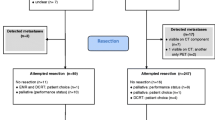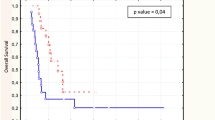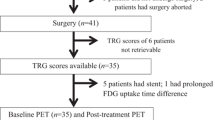Abstract
Aims
A study was undertaken to investigate the value of pretreatment PET–CT in predicting survival in patients with oesophageal cancer (OC).
Methods
Between June 2010 and December 2011, 18 consecutive OC patients median (61.00 ± 12.07 years) with median survival of 7.5 month had a pretreatment PET–CT scan. Staging of the disease was made in accordance to the American Joint Committee on Cancer staging system (7th edition) and grouped as stage I–IIA and stage IIB–IV. Maximum standardized uptake value (SUVmax), size of a primary tumour and the presence of fluorodeoxyglucose (FDG)-avid lymph nodes were evaluated for all patients. Survival was analysed using the Kaplan–Meier product limit method and Cox proportional hazards regression model.
Results
PET–CT stages I–IIA and IIB–IV had a 1-year survival of 50% and 25%, respectively. Patient with size of primary tumour (<4.5 cm) had significantly (p < 0.036) better survival than those with large size (>4.5 cm). Multivariate Cox regression analysis showed that SUVmax of >5.5 in the primary tumour [hazard ratio (HR) 23.017; 95% confidence interval, p = 0.038] and the presence of FDG-avid lymph node (HR 1.248; p = 0.028) were strongly predictive of poor overall survival on multivariate analysis.
Conclusion
Pretreatment 18F-FDG PET–CT SUVmax of a primary tumour and the presence of FDG-avid lymph nodes independently predict survival in patients with oesophageal carcinoma which may potentially be used as surrogate markers for prognostic and therapeutic purposes.






Similar content being viewed by others
References
Surveillance Epidemiology and End Results (SEER). Available at: http://seer.cancer.gov/statistics/. Accessed April 16, 2012
Skehan SJ, Brown AL, Thompson M, et al. (2000) Imaging features of primary and recurrent esophageal cancer at FDG PET. Radiographics 20(3):713
American Cancer Society (2003) Cancer facts and figures 2003. Atlanta: American Cancer Society
Westerterp M, Sloof GW, Hoekstra OS, et al. (2008) 18FDG uptake in esophageal adenocarcinoma: linking biology and outcome. J Cancer Res Clin Oncol 134:227–236
Choi JY, Lee KH, Shim YM, et al. (2000) Improved detection of individual nodal involvement in squamous cell carcinoma of the esophagus by FDG PET. J Nucl Med 41:808–815
Lina C-Y, Dingb H-J, Chenc Y-K, et al. (2008) F-18 FDG PET in detecting uterine leiomyoma. Clin Imaging 32(1):38–41
van Vliet EP, Heijenbrok-Kal MH, Hunink MG, Kuipers EJ, Siersema PD (2008) Stag-ing investigations for oesophageal cancer: a meta-analysis. Br J Cancer 98:547–557
Fathinul Fikri AS, Kroiss A, Ahmad ZF, et al. (2014) Localization and prediction of malignant potential in recurrent pheochromocytoma/paraganglioma (PCC/PGL) using 18F-FDG PET/CT. Acta Radiol 55(5):631–640. doi:10.1177/0284185113504330
Fukunaga T, Okazumi S, Koide Y, Isono K, Imazeki K (1998) Evaluation of esophageal cancers using fluorine-18-fluorodeoxyglucose PET. J Nucl Med 39:1002–1007
Rizk NP, Tang L, Adusumilli PS, et al. (2009) Predictive value of initial PET-SUVmax in patients with locally advanced esophageal and gastroesophageal junction adenocarcinoma. J Thorac Oncol. 4(7):875–879
Fathinul F, Nordin AJ, Lau WFE (2013) 18[F] FDG-PET/CT is a useful molecular marker in evaluating tumour aggressiveness; a revised understanding of an in-vivo FDGPET imaging that alludes the alteration of cancer biology. Cell Biochem Biophys 66:37–43. doi:10.1007/s12013-012-9395-5
Fathinul Fikri AS, Nordin AJ, Mokhtarudin N, Hemalata A, Lau WFE (2011) 18[F] FDG-PET/CT is a useful molecular marker in evaluating thymoma aggressiveness. Eur J Radiol Extra. 78(2):89–92
Rice TW, Blackstone EH, Rusch VW (2010) 7th Edition of the AJCC Cancer Staging Manual: esophagus and esophagogastric junction. Ann Surg Oncol 17(7):1721–1724
Kato H, Kimura H, Nakajima M, et al. (2008) The additional value of integrated PET/CT over PET in initial lymph node staging of esophageal cancer. Oncol Rep 20:857–862
Roedl JB, Prabhakar HB, Mueller PR, Colen RR, Blake MA (2009) Prediction of metastatic disease and survival in patients with gastric and gastroesophageal junction tumors: the incremental value of PET-CT over PET and the clinical role of primary tumor volume measurements. Acad Radiol 16:218–226
Yasuda T, Higuchi I, Yano M, et al. (2012) The impact of 18F-fluorodeoxyglucose positron emission tomography positive lymph nodes on postoperative recurrence and survival in resectable thoracic esophageal squamous cell carcinoma. Ann Surg Oncol 19:652–660
Gillies RS, Middleton MR, Han C, et al. (2012) Role of positron emission tomography-computed tomography in predicting survival after neoadjuvant chemotherapy and surgery for oesophageal adenocarcinoma. Br J Surg 99(2):239–245
Williams RN, Ubhi SS, Sutton CD, et al. (2009) The early use of PET-CT alters the management of patient with esophageal cancer. J Gastrointes Surg 13:868–873
Boris S, Daniel PR, Marek P, et al. (2009) Does the value of PET-CT extend beyond pretreatment staging? An analysis of survival in surgical patients with esophageal cancers. J Gastrointest Surg. doi:10.1007/s11605-009-1038-9
Facey K, Bradbury I, Laking G, et al. (2007) Overview of the clinical effectiveness of positron emission tomography imaging in selected cancers. Health Technol Assess 11:iii-iv, xi-267
Vliet EPM, Heijenbrok-Kal MH, Hunink MGM, et al. (2008) Staging investigation for esophageal cancer: a meta-analysis. Br J Cancer 98:547–557
Vaupel P, Mayer A (2007) Hypoxia in cancer: significance and impact on clinical outcome. Cancer Metastasis Rev 26:225–239
Wang BY, Goan YG, Hsu PK, Hsu WH, Wu YC (2011) Tumor length as a prognostic factor in esophageal squamous cell carcinoma. Ann Thorac Surg 91(3):887–893. doi:10.1016/j.athoracsur.2010.11.011
Wu N, Pang LW, Chen ZM, Ma QY, Chen G (2012) Tumour length is an independent prognostic factor of esophageal squamous cell carcinomas. Chin Med J. 125(24):4445–4448
Wang BY, Liu CY, Lin CH, et al. (2012) Endoscopic tumor length is an independent prognostic factor in esophageal squamous cell carcinoma. Ann Surg Oncol 19(7):2149–2158
Hyun SH, Choi JY, Shim YM, et al. (2010) Prognostic value of metabolic tumor volume measured by 18F-fluorodeoxyglucose positron emission tomography in patients with esophageal carcinoma. Ann Surg Oncol 17(1):115–122
Acknowledgments
We are grateful to Dr R. Dharmendran and his colleagues of the Hospital Tuanku Ja’afar Seremban for their joint effort in the data collection process for all patients in this study.
Conflict of interest
None.
Author information
Authors and Affiliations
Corresponding author
Rights and permissions
About this article
Cite this article
Fathinul Fikri, A.S., Dharmendran, R., Vikneswaran, P. et al. 18F-FDG PET/CT as a potential predictor of survival in patient with oesophageal cancer: a preliminary result. Abdom Imaging 40, 1457–1464 (2015). https://doi.org/10.1007/s00261-014-0343-2
Published:
Issue Date:
DOI: https://doi.org/10.1007/s00261-014-0343-2




